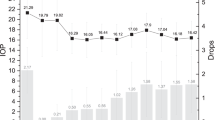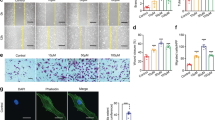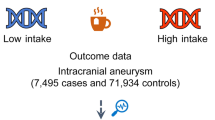Abstract
Purpose
To examine the effects of caffeinated coffee consumption on intraocular pressure (IOP), ocular perfusion pressure (OPP), and ocular pulse amplitude (OPA) in those with or at risk for primary open-angle glaucoma (POAG).
Methods
We conducted a prospective, double-masked, crossover, randomized controlled trial with 106 subjects: 22 with high tension POAG, 18 with normal tension POAG, 20 with ocular hypertension, 21 POAG suspects, and 25 healthy participants. Subjects ingested either 237 ml of caffeinated (182 mg caffeine) or decaffeinated (4 mg caffeine) coffee for the first visit and the alternate beverage for the second visit. Blood pressure (BP) and pascal dynamic contour tonometer measurements of IOP, OPA, and heart rate were measured before and at 60 and 90 min after coffee ingestion per visit. OPP was calculated from BP and IOP measurements. Results were analysed using paired t-tests. Multivariable models assessed determinants of IOP, OPP, and OPA changes.
Results
There were no significant differences in baseline IOP, OPP, and OPA between the caffeinated and decaffeinated visits. After caffeinated as compared with decaffeinated coffee ingestion, mean mm Hg changes (±SD) in IOP, OPP, and OPA were as follows: 0.99 (±1.52, P<0.0001), 1.57 (±6.40, P=0.0129), and 0.23 (±0.52, P<0.0001) at 60 min, respectively; and 1.06 (±1.67, P<0.0001), 1.26 (±6.23, P=0.0398), and 0.18 (±0.52, P=0.0006) at 90 min, respectively. Regression analyses revealed sporadic and inconsistent associations with IOP, OPP, and OPA changes.
Conclusion
Consuming one cup of caffeinated coffee (182 mg caffeine) statistically increases, but likely does not clinically impact, IOP and OPP in those with or at risk for POAG.
Similar content being viewed by others
Log in or create a free account to read this content
Gain free access to this article, as well as selected content from this journal and more on nature.com
or
References
Quigley H . Number of people with glaucoma worldwide. Br J Ophthalmol 1996; 80: 389–393.
Nemesure B, Honkanen R, Hennis A, Wu SY, Leske MC . Incident open-angle glaucoma and intraocular pressure. Ophthalmology 2007; 114: 1810–1815.
Leske MC, Connell AMS, Wu S-Y, Nemesure B, Li X, Schachat A et al. Incidence of open-angle glaucoma: the Barbados Eye Studies. Arch Ophthalmol 2001; 119: 89–95.
Gordon MO, Beiser JA, Brandt JD, Heuer DK, Higginbotham EJ, Johnson CA et al. The Ocular HypertensionTreatment Study: baseline factors that predict the onset of primary open-angle glaucoma. Arch Ophthalmol 2002; 120: 714–720.
The AGIS Investigators. The Advanced Glaucoma Intervention Study (AGIS): 7. The relationship between control of intraocular pressure and visual field deterioration. Am J Ophthalmol 2000; 130: 429–440.
Leske MC, Heijl A, Hussein M, Bengtsson B, Hyman L, Komaroff E . Factors for glaucoma progression and the effect of treatment: the early manifest glaucoma trial. Arch Ophthalmol 2003; 121: 48–56.
Le A, Mukesh BN, McCarty CA, Taylor HR . Risk factors associated with the incidence of open-angle glaucoma: the Visual Impairment Project. Invest Ophthalmol Vis Sci 2003; 44: 3783–3789.
de Voogd S, Ikram K, Wolfs RCW, Jansonius NM, Hofman A, de Jong PTVM . Incidence of open-angle glaucoma in a general elderly population: the Rotterdam Study. Ophthalmol 2005; 112: 1487–1493.
Cedrone C, Mancino R, Ricci F, Cerulli A, Culasso F, Nucci C . The 12-year incidence of glaucoma and glaucoma-related visual field loss in Italy: the Ponza Eye Study. J Glaucoma 2012; 21: 1–6.
Tielsch JM, Katz J, Sommer A, Quigley HA, Javitt JC . Hypertension, perfusion pressure, and primary open-angle glaucoma: a population-based assessment. Arch Ophthalmol 1995; 113: 216–221.
Leske MC, Connell AM, Wu SY, Hyman LG, Schachat MD . Risk factors for open-angle glaucoma. The Barbados Eye Study. Arch Ophthalmol 1995; 113: 918–924.
Bonomi L, Marchini G, Marraffa M, Bernardi P, Morbio R, Varotto A . Vascular risk factors for primary open angle glaucoma: the Egna-Neumarkt Study. Ophthalmology 2000; 107: 1287–1293.
Quigley HA, West SK, Rodriguez J, Munoz B, Klein R, Snyder R . The prevalence of glaucoma in a population-based study of Hispanic subjects: Proyecto VER. Arch Ophthalmol 2001; 119: 1819–1826.
Hulsman CA, Vingerling JR, Hofman A, Witteman JC, Jong PT . Blood pressure, arterial stiffness, and open-angle glaucoma: the Rotterdam study. Arch Ophthalmol 2007; 125: 805–812.
Leske MC, Wu SY, Nemesure B, Hennis A . Incident open-angle glaucoma and blood pressure. Arch Ophthalmol 2002; 120: 954–959.
Leske MC, Wu SY, Hennis A, Honkanen R, Nemesure B . BESs Study Group. Risk factors for incident open-angle glaucoma: the Barbados Eye Studies. Ophthalmology 2008; 115: 85–93.
Leske MC, Heijl A, Hyman L, Bengtsson B, Dong L, Yang Z et al. Predictors of long-term progression in the early manifest glaucoma trial. Ophthalmology 2007; 114: 1965–1972.
Zheng Y, Wong TY, Mitchell P, Friedman D, Mingguang H, Aung T . Distribution of ocular perfusion pressure and its relationship with open-angle glaucoma: the Singapore Malay Eye Study. Invest Ophthalmol Vis Sci 2010; 51: 3399–3404.
Pasquale LR, Kang JH . Lifestyle, nutrition and glaucoma. J Glaucoma 2009; 18: 423–428.
Massey LK . Caffeine and the elderly. Drugs Aging 1998; 13: 43–50.
Traverso CE, Walt JG, Kelly SP, Hommer AH, Bron AM, Denis P et al. Direct costs of glaucoma and severity of the disease: a multinational long term study of resource utilisation in Europe. Br J Ophthalmol 2005; 89: 1245–1249.
Lee PP, Walt JG, Doyle JJ, Kotak SV, Evans SJ, Budenz DL et al. A multicenter, retrospective pilot study of resource use and costs associated with severity of disease in glaucoma. Arch Ophthalmol 2006; 124: 12–19.
Gieser DK, Tracy Williams R, O'Connell W, Pasquale LR, Rosenthal BP, Walt JG et al. Costs and utilization of end-stage glaucoma patients receiving visual rehabilitation care: a US multisite retrospective study. J Glaucoma 2006; 15: 419–425.
Coffee Statistics Report 2011. http://www.coffee-statistics.com/coffee_statistics_ebook.html. accessed 25 May 2011.
Ozkan B, Yuksel N, Anik Y, Altintas O, Demirci A, Caglar Y . The effect of caffeine on retrobulbar hemodynamics. Curr Eye Res 2008; 33: 804–809.
Ricklefs G . Studies on the ways of life of glaucoma patients. Doc Ophthalmol 1968; 25: 43–99.
Ricklefs G, Pohls EU . Effect of caffeine containing tablets and Coca-Cola on the intraocular pressure of patients without glaucoma and patients with regulated glaucoma. Klin Monatsbl Augenheilkd 1969; 154: 546–551.
Okuno T, Sugiyama T, Tominaga M, Kojima S, Ikeda T . Effects of caffeine on microcirculation of the human ocular fundus. Jpn J Ophthalmol 2002; 46: 170–176.
Lofti K, Grunwald JE . The effect of caffeine on the human macular circulation. Invest Ophthalmol Vis Sci 1991; 32: 3028–3032.
Chandra P, Gaur A, Varma S . Effect of caffeine on the intraocular pressure in patients with primary open angle glaucoma. Clin Ophthalmol 2011; 5: 1623–1629.
Avisar R, Avisar E, Weinberger D . Effect of coffee consumption on intraocular pressure. Ann Pharmacother 2002; 36: 992–995.
Higginbotham EJ, Kilimanjaro HA, Wilensky JT, Batenhorst RL, Hermann D . The effect of caffeine on intraocular pressure in glaucoma patients. Ophthalmology 1989; 96: 624–626.
Okimi PH, Sportsman S, Pickard MR, Fritsche MB . Effects of caffeinated coffee on intraocular pressure. Appl Nurs Res 1991; 4: 72–76.
Ajayi OB, Ukwade MT . Caffeine and intraocular pressure in a Nigerian population. J Glaucoma 2001; 10: 25–31.
Graeber W . On the effect of caffeine on intraocular pressure in surgically or conservatively managed simple chronic glaucoma. Klin Monatsbl Augenheilkd 1968; 152: 357–650.
Makabe R . Uber die Reaktionsdifferenz von Normal-und Glaucomaugen and Provokationstest. Ophthalmologica 1970; 161: 460–465.
Li M, Wang M, Guo W, Wang J, Sun X . The effect of caffeine on intraocular pressure: a systematic review and meta-analysis. Graefes Arch Clin Exp Ophthalmol 2011; 249: 435–442.
The Primary Open-Angle Glaucoma Genes and Environment (GLAUGEN) Study. Study Accession: phs000308.v1.p1. www.ncbi.nlm.nih.gov/gap?term=glaugen. accessed 29 March 2011.
Mills RP, Budenz DL, Lee PP, Noecker RJ, Walt JG, Siegartel LR et al. Categorizing the stage of glaucoma from pre-diagnosis to end-stage disease. Am J Ophthalmol 2006; 141: 24–30.
Caffeine Questionnaire. 2004; Fred Hutchinson Cancer Research Center. www.phenxtoolkit.org. accessed 20 May 2011, Ver 4.4.
Schweenn O, Troost R, Vogel A, Grus F, Beck S, Pfeiffer N . Ocular pulse amplitude in patients with open angle glaucoma, normal tension glaucoma, and ocular hypertension. Br J Ophthalmol 2002; 86: 981–984.
Vulsteke C, Stalmans I, Fieuws S, Zeyen T . Correlation between ocular pulse amplitude measured by dynamic contour tonometer and visual field defects. Graefes Arch Clin Exp Ophthalmol 2008; 246: 559–565.
Stalmans I, Harris A, Vanbellinghen V, Zeyen T, Siesky B . Ocular pulse amplitutde in normal tension and primary open angle glaucoma. J Glaucoma 2008; 17: 403–407.
Mort JR, Kruse HR . Timing of blood pressure measurement related to caffeine consumption. Ann Pharmacother 2008; 42: 105–110.
American Hospital Formulary Service – drug information. American Society of Health System Pharmacists: Bethesda, MD, 2006; 2431–2432.
Nurminen M-L, Niittynen L, Korpela R, Vapaatalo H . Coffee caffeine and blood pressure: a critical review. Eur J Clin Nutr 1999; 53: 831–839.
Kurata K, Fujimoto H, Tsukuda R, Suzuki T, Ando T, Tokuriki M . Aqueous humor dynamics in beagle dogs with caffeine-induced ocular hypertension. J Vet Med Sci 1998; 60: 737–739.
James JE . Critical review of dietary caffeine and blood pressure: a relationship that should be taken more seriously. Psychosom Med 2004; 66: 63–71.
Haller CA . Caffeine. In: Olson KR (ed) Poisoning and drug overdose. 5th ed. New York: Lange Medical Books/McGraw-Hill: New York, 2007, pp 142–143.
Fuller RW, Maxwell DL, Conradson T-BG, Dixon CMS, Barnes PJ . Circulatory and respiratory effects of infused adenosine in conscious man. Br J Pharmacol 1987; 24: 309–317.
Smits P, Boekema P, De Abreu R, Thien T, van't Laar A . Evidence for an antagonism between caffeine and adenosine in the human cardiovascular system. J Cardiovasc Pharmacol 1987; 10: 136–143.
Coney AM, Marshall JM . Role of adenosine and its receptors in the vasodilation induced in the cerebral cortex of the rat by systemic hypoxia. J Physiol 1998; 509: 507–518.
Hartley TR, Lovallo WR, Whitsett TL, Sung BH, Wilson MF . Caffeine and stress: implications for risk, assessment, and management of hypertension. J Clin Hypertens 2001; 3: 354–361.
Kurata K, Maeda M, Nishida E, Tsukuda R, Suzuki T, Ando T et al. Relationship between caffeine induced ocular hypertension and ultrastructure changes of nonpigmented ciliary epithelial cells in rats. J Toxicol Sci 1997; 22: 447–454.
Adams BA, Brubaker RF . Caffeine has no clinically significant effect on aqueous humor flow in the normal human eye. Ophthalmology 1990; 8: 1030–1031.
Raebel MA, Black J . The caffeine controversy: what are the facts? Hospital Pharm 1984; 19: 257–267.
Chandrasekaran S, Rochtchina E, Mitchell P . Effects of caffeine on intraocular pressure. J Glaucoma 2005; 14: 504–507.
Kang JH, Willett WC, Rosner BA, Hankinson SE, Pasquale LR . Caffeine consumption and the risk of primary open-angle glaucoma: a Prospective Cohort Study. Invest Ophthalmol Vis Sci 2008; 49: 1924–1931.
Acknowledgements
This work was supported by a Fight for Sight Postdoctoral Grant (Angela V Turalba). Aliya Z Jiwani is funded by a Doris Duke Charitable Foundation One-Year Clinical Research Fellowship and a Yale School of Medicine Summer Fellowship. Louis R Pasquale is supported by a Research to Prevent Blindness Physician Scientist Award, Harvard Medical School Ophthalmology Scholar Award, and an Allergan Horizon Award.
Author information
Authors and Affiliations
Corresponding author
Ethics declarations
Competing interests
The authors declare no conflict of interest.
Additional information
This work was presented as a poster at the American Glaucoma Society Meeting in New York City on 3 March 2012.
Rights and permissions
About this article
Cite this article
Jiwani, A., Rhee, D., Brauner, S. et al. Effects of caffeinated coffee consumption on intraocular pressure, ocular perfusion pressure, and ocular pulse amplitude: a randomized controlled trial. Eye 26, 1122–1130 (2012). https://doi.org/10.1038/eye.2012.113
Received:
Accepted:
Published:
Issue date:
DOI: https://doi.org/10.1038/eye.2012.113
Keywords
This article is cited by
-
Effects of caffeine on intraocular pressure are subject to tolerance: a comparative study between low and high caffeine consumers
Psychopharmacology (2019)
-
The Role of Diet in Glaucoma: A Review of the Current Evidence
Ophthalmology and Therapy (2018)
-
Caffeine intake is associated with pupil dilation and enhanced accommodation
Eye (2017)
-
Modifiable factors in the management of glaucoma: a systematic review of current evidence
Graefe's Archive for Clinical and Experimental Ophthalmology (2017)
-
The effect of flammer-syndrome on retinal venous pressure
BMC Ophthalmology (2014)



